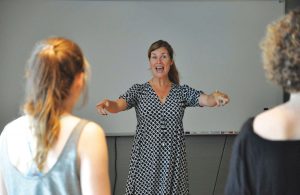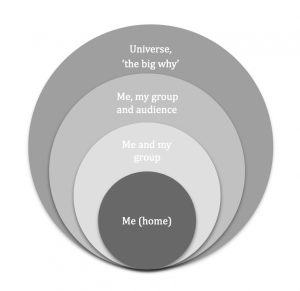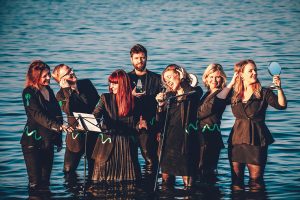Astrid Vang-Pedersen, Conductor, Malling, Denmark
Background
During studies at The Royal Danish Academy of Music, I became curious about the many conventions concert performances entail, and I became motivated to investigate what would happen if we developed a wider perspective on the concert event. This marked the beginning of my research. In 2018 I completed my Ph.D.: “Concert Design – an investigation into the potential of Classical Concerts as creatively designed events”.
The Research Project
The research project investigated how “design” can performatively change the familiar concert setup through theatrical devices, interdisciplinary dramaturgies, and site-specific interventions. Through combining academic research with studies of alternative concert productions and my own exploratory concert cases, the research demonstrated how a meaningful present-day concert may be designed as a unified interdisciplinary event.
Essentially, the contribution of the research is my concept of Concert Design. The Concert Design Concept consists of a Concert Design Model, a Concert Design Process and Concert Design Methods, which have also proved to be useful beyond the classical music scene including a variety of musical genres.
The Concert Design Model prescribes how the musical repertoire and the three performing aspects (Performers, Audience and Performance Space), may constitute flexible relationships in a performance through the creative engagement with six Concert Design Principles:
- Story
- Structure
- Sensory
- Surprise
- Specificity
- Shared

Concert Design Methods
While the Concert Design Principles are useful when conceptualizing an event, the execution of concepts rely on the skills of the performers. Performer Development focuses on the performer’s responsibility and desire to engage an audience through reflections on and development of own performance. Basically the core question we as performers must ask ourselves is “Why” should an audience come to this performance, message through performance?”.
The research points to the following areas:
- Performers Development: The embodied perspective
- Creating a scene: The aesthetic, visual and spatial perspective
- Concert Design Concept: The holistic perspective

- Performers Development: – The embodied perspective
As musical performers, our instruments are naturally linked to our bodies. We produce sound as singers and as musicians we internalize awareness on musical elements such as rhythmical patterns, singing on pitch, developing diversity in sound and expression and consequently externalizing the interpretation of the musical material.
Historically, there has been little focus on developing the expression and perception of the performing body when performing classical music. Being an ensemble singer or musician is conventionally perceived as a neutral role, that does not require “performing” in a dramatic or communicating way – the music “performs” on its own. Hence the natural starting point for Performers Development is a restored awareness of the body as an expressive and communicating performer.
A simplistic model of the body divided into three levels may work as a guideline:
-
- Level A – From hips and down (Grounding, primal power & vertical focus)
- Level B – Torso (Heart, emotion & horizontal focus)
- Level C – Head (Intellectual, ethereal, spiritual & vertical focus)
The levels provide tangible tools to use when articulating common intentions, for instance: “’what’ are we communicating right now, and from ‘where’ is this communication deriving?” The levels may also be helpful when speaking practically or metaphorically about the common sound we as an ensemble are pursuing. Working practically on body awareness involves incorporating physical exercises in the beginning and during rehearsal to keep the focus present. A greater awareness of the body enables variety in how to position singers and musicians on stage as well as the potential of incorporating movement or choreographies.
An Image of Me in the World
Russian actor and teacher Konstantin Stanislavskij (1863-1938) developed a technique for teaching actors, which involved the “Four circles of attention”. Each circle symbolizes a point of attention, where circle one is attention on one self, circle two out towards others around you nearby, circle three includes the rest of the world and circle four the universal aspect of being.
“You may always, anytime during a show, in front of thousands of people looking at you, pull yourself back to the solitude (of the small circle), just like a snail recedes to its shell” (Stanislavskij 1988, p.136)

The circles represent another useful tool in verbalizing where focus is while performing a certain section of a piece, not as a drama or an act, but as a direct or indirect communication between performers and audiences.
- Circle 1 (Me, also referred to as “Home”)
- Circle 2 (Me and my immediate group)
- Circle 3 (Me, my immediate group and everyone else, including audience)
- Circle 4 (Me, and everything I can encounter, and the universal aspect of being)
- Creating a Scene – Staging & Choreography
When staging a scene – a musical piece – in the rehearsal room, the primary focus is on the potential visual expression of the embedded musical qualities. Oftentimes I begin by constructing possible ways of staging a piece by drawing on a piece of paper. I mark the performers with x and their movements with arrows. Sometimes one piece requires many drawings that match the sections of the music. I bring the idea to rehearsal, where I try out the staging with the performers. Through repeated rehearsals, adjustments are made and bodily expressions and circles of attention are added to the performance.
The staging of a piece is a combined embodied, visual and spatial act. The music may call for certain spatiality, due to its composition or in the technicality of its performance. But the space also informs the staging just as the performers do. Sometimes a Concert Design is created with a specific space in mind, like a “site-specific”, and sometimes it is developed purely on the basis of the music and the performers, and must be adjusted accordingly in the performance space.
- Concert Design: A holistic approach to the performative event
Put in simple terms, a concert is a number of “scenes” put together into a rundown. This is where the musical pieces are lined up in a narrative or a dramatic curve shaping the performance. It is this part of the Concert Design Process that invites engagement with the Concert Design Principles.
The overarching Concert Design Principles are: Story and Structure, where Story is what guides the staging of both specific pieces and overall rundowns. Structure places the event in between a before and after – adding the perspective that the overall experience includes what happens right before and right after. The principles ofSensory and Surprise are incorporated in how the space informs the design, and how it inspires choreography, clothing, lighting, scenography etc., while Specificity and Shared focus on who we are as performers, who our audiences are and what we share.
To summarize Concert Design is the creative and reflective act of viewing the entire event as a holistic experience, where visual, embodied and spatial elements influence and underline the musical message and the engagement of audiences.
For further reading, rehearsal exercises and examples of Concert Design visit: www.concertdesign.dk

References
- Stanislavskij, Konstantin: ”En skuespillers arbejde med sig selv”, Nyt Nordisk Forlag Arnold Busck A/S 1988, Copenhagen, 4th edition. Translated from Russian. Chapter 5, p.119-1164
- Vang-Pedersen, Astrid (2018): “Concert Design – an investigation into the potential of Classical Concerts as creatively designed event”. www.concertdesign.dk
- Vang-Pedersen, Astrid (2015): “Re-thinking the classical concert” in Engaging Spaces – Sites of performance, interaction and reflection, Museum Tusculanum 2015
 Astrid Vang-Pedersen has developed the concept Concert Design, through her doctoral work titled: “Concert Design – an investigation into the potential of Classical Concerts as creatively designed events”. The Concert Design concept consists of 6 Concert Design Principles that enable inspirational, innovative, relevant and unique musical performances. Astrid is the artistic director of Vocal Ensemble Dopplers, which emphasizes Concert Design in their performances. She works as a freelance educator and performance coach facilitating master-classes and workshops. Astrid has created an international choral collaboration Ubuntusong promoting cross-cultural understanding through singing. www.concertdesign.dk — www.dopplers.dk — www.ubuntusong.com
Astrid Vang-Pedersen has developed the concept Concert Design, through her doctoral work titled: “Concert Design – an investigation into the potential of Classical Concerts as creatively designed events”. The Concert Design concept consists of 6 Concert Design Principles that enable inspirational, innovative, relevant and unique musical performances. Astrid is the artistic director of Vocal Ensemble Dopplers, which emphasizes Concert Design in their performances. She works as a freelance educator and performance coach facilitating master-classes and workshops. Astrid has created an international choral collaboration Ubuntusong promoting cross-cultural understanding through singing. www.concertdesign.dk — www.dopplers.dk — www.ubuntusong.com
Edited by Patricia Abbott, Canada

